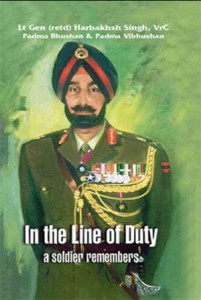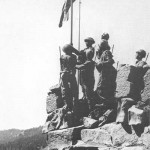 It is also amazing what the power of self suggestion can do. The Air Commodore in-charge of the airfield at Ambala, reported to me, over the telephone, that he could see parachutes coming down to land on the east end of the landing strip, and claimed to be counting them as they descended, before his very eyes. His tally was fifteen and more. I found this hard to believe, as it made no sense. Why would paratroopers land so far away from the Pakistan border with no chance of escape? However, I instructed my Chief of Staff to arrange for two truck-loads of soldiers, and ask them to drive, with full lights on, along the airstrip to look for the parachutes. For, I was sure, the paratroopers were bound to leave their parachutes behind. The troops in the trucks scanned the whole airfield, but found no sign of a parachute, let alone of a paratrooper! It just goes to show how fear can make you imagine all sorts of things. The Air Commodore, who spoke to me on the telephone, had perhaps taken a few low clouds to be a group of descending parachutes!To continue with the wonderful support we received from the public. We had to requisition some civilian trucks, from Punjab, to carry ammunition to the leading troops. They were required to dump the ammunition at the Frontline and return. But none of them wanted to leave the troops, and continued to stay, saying that if the troops could bear the bullets of the enemy, why couldn’t they? They learnt road-discipline and how to camouflage their trucks and themselves. They were also very good at disposing of vehicle casualties – whether they be ours or the enemy’s. Once I was visiting I Corps, when I saw a civilian truck, fully camouflaged, standing by. The driver of the truck, a civilian, was carrying the complete rear axle of a vehicle on his shoulders. When I enquired from him as to what he was doing, he mentioned that he had taken it out of an enemy vehicle, as it fitted his own, and he would keep it as a spare with him!
It is also amazing what the power of self suggestion can do. The Air Commodore in-charge of the airfield at Ambala, reported to me, over the telephone, that he could see parachutes coming down to land on the east end of the landing strip, and claimed to be counting them as they descended, before his very eyes. His tally was fifteen and more. I found this hard to believe, as it made no sense. Why would paratroopers land so far away from the Pakistan border with no chance of escape? However, I instructed my Chief of Staff to arrange for two truck-loads of soldiers, and ask them to drive, with full lights on, along the airstrip to look for the parachutes. For, I was sure, the paratroopers were bound to leave their parachutes behind. The troops in the trucks scanned the whole airfield, but found no sign of a parachute, let alone of a paratrooper! It just goes to show how fear can make you imagine all sorts of things. The Air Commodore, who spoke to me on the telephone, had perhaps taken a few low clouds to be a group of descending parachutes!To continue with the wonderful support we received from the public. We had to requisition some civilian trucks, from Punjab, to carry ammunition to the leading troops. They were required to dump the ammunition at the Frontline and return. But none of them wanted to leave the troops, and continued to stay, saying that if the troops could bear the bullets of the enemy, why couldn’t they? They learnt road-discipline and how to camouflage their trucks and themselves. They were also very good at disposing of vehicle casualties – whether they be ours or the enemy’s. Once I was visiting I Corps, when I saw a civilian truck, fully camouflaged, standing by. The driver of the truck, a civilian, was carrying the complete rear axle of a vehicle on his shoulders. When I enquired from him as to what he was doing, he mentioned that he had taken it out of an enemy vehicle, as it fitted his own, and he would keep it as a spare with him!
Bridges and culverts on the GT Road were guarded by villagers, and I remember, being stopped on the road, for purposes of identification, by NCC cadets at all odd hours. While the peasants did not give up performing their chores right up to the international border; boys and girls’ from the Punjab had set up stalls of milk, lassi, prasad and puries at every crossroad and would force troops going to the. Front, or returning, to partake of their wares. If a vehicle carrying troops was in a hurry and could not stop, they would throw biscuits and fruit into it. Normally, I was always in a hurry and did not stop.
But none of them wanted to leave the troops, and continued to stay, saying that if the troops could bear the bullets of the enemy, why couldnt they?
Once, however when I was returning from the front, the girls formed a chain across the road by holding hands and forced me to stop my jeep. They insisted on serving my party and I puries and prasad on ‘patals’ (made of leaves). As I was eating, I saw a bus standing by, with some Pakistanis in uniform in it, they were being fed by the girls like everyone else. The Pakistanis, the girls told me, were prisoners-of-war being taken back. I saw a JCO, with some men, obviously their escort, standing nearby. I signalled to the JCO to come and see me and asked him why the prisoners-of-war had not been blind-folded. He said that they had been, but that the girls had demanded that the bandages over their eyes be removed so that they could eat comfortably. I reminded the JCO of his responsibility and asked him to blind-fold them again before moving off. Such was the hospitality and fair-mindedness of the Punjabis!
Ambala, as my Main Headquarters, I felt, was too far behind from the Front, to enable me to control the battle as well as attend to my Headquarters. I had no choice but to leave the management of ‘the Main Headquarters entirely in the hands of my Chief of Staff, Major General Joginder Singh, including the management of the Air-Support, as I was mostly busy conducting the battle from the front:
During the war, whenever I was in my Main Headquarters, at Ambala, I used to ring up my family who were in Simla. One day my wife mentioned that air-alarms had begun to sound very often in Simla, and with two school-going girls (my daughters) with her, what was she to do? I told her not to bother about these alarms as there was no danger of Simla being bombed by the Pakistanis, and asked her to let this be known to friends, should they ask. Once I visited my family in Simla, and there was a message waiting for me from the Loretto Convent (my children’s school) that the ‘Sister-General’ wished to see me and would come to the house whenever I happened to come to Simla. My reply was, “Surely, ‘Sister-General’ cannot come to a I Lieutenant General’s house, I must go to her.” So I rang up the Loretto Convent and fixed a visit with the ‘Sister-General’ at the Convent. When I arrived, tea had been arranged in the Convent parlour for me, and how beautifully clean every thing was – the room, the rug and the linen. The ‘Sister-General’ (an Irish woman) met me and wished to know if she should close down the school, because, or the War with Pakistan, and send the girls home? I replied: “Nothing., of the sort; there is no danger to the Convent, or Simla for that matter, from the Pakistanis. The school should continue as normal.”
As I was eating, I saw a bus standing by, with some Pakistanis in uniform in it, they were being fed by the girls like everyone else.
I Corps was launched early on the morning of the 8th of September in the Sialkot Sector. The idea was to establish a ‘bridge-head’, by a Brigade of 14 Infantry Division, to serve as a spring-board for launching our main strike element – the 1st Armoured Division – with the object of capturing the bridge on the spill-channel (which supplied water to the Ichhogil Canal), behind Sialkot, as soon as possible. Simultaneously, 26 Infantry Division were to attack Sialkot town frontally, so as to engage the Sialkot defences, and protect the right flank of the Armoured Division’s advances, while 14 Infantry Division were to capture Zafarwal. 1 Armoured Division broke-out of the bridge-head punctually at 6 am on the 8th of September, but the 43 Lorried Infantry Brigade Group was grounded to a halt in a vast quagmire created by a heavy shower of rain the previous day. After a couple of miles advance, 1 Armoured Division came across some armour and an anti-tank nest, and having cleared them, got involved in some internecine encounters and’ soon limped to a dead-halt with the mishandling of armour both at Brigade and Divisional levels. The Armoured Division which was supposed to penetrate deep and to the rear of Sialkot, through mistakes on their part, had only advanced 4 miles after break-out from the bridge-head, when there was very scanty armour opposition ranged against them. There was no doubt that due to incompetence of command a great opportunity had been lost!





GIBRALTAR , BARKI AND MAJ BHATTI’S LAST BATTLE – A VIEW FROM BOTH SIDES
This is relevant here.——
22 —– It therefore is inconsistent with the facts on ground when Lt Col (retd) Syed Shahid Abbas (Nine Crucial Hours – When Courage Outmaneuvered Strength) writes that ‘‘after the declaration of ceasefire on 23 September as per the information received from across the border, the Indians had suffered 400 casualities’’. Equally incongruous is that Gen Harbaksh in his book ‘War Despatches’ (Para 43,Page 49 ) mentions —‘’General Officer Commanding 7 Division appreciating that 48 Infantry Brigade had suffered fairly heavy casualities in the battle for Hudiara Drain, switched 65 Infantry Brigade Group into the lead—‘’ . This was certainly not the case as we shall see later on. Infact the same can be verified from 48 Infantry Brigade records and from the casuality returns of 7 Infantry Division even today.
33 There were casualities on both sides but nothing like the four truckloads of corpses including the dead body of Maj Aziz Bhati—‘’ lifted from the battle field by the Pakistanis after permission was given for collection of their dead.’’ This excerpt as mentioned in Para 47 Page 53 by Gen Harbaksh in his book ‘War Despatches’ needs to be corrected.
Further reading papyrustony.blogspot.in/2014/02/gibraltar-barki-andmaj-bhattis-last.html